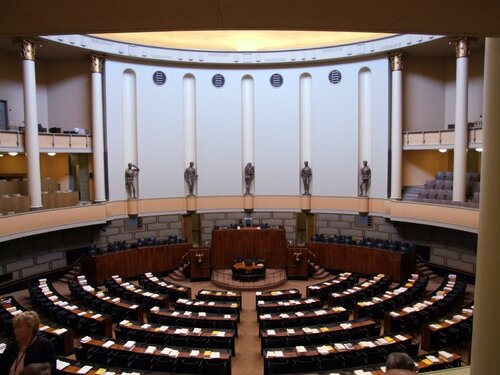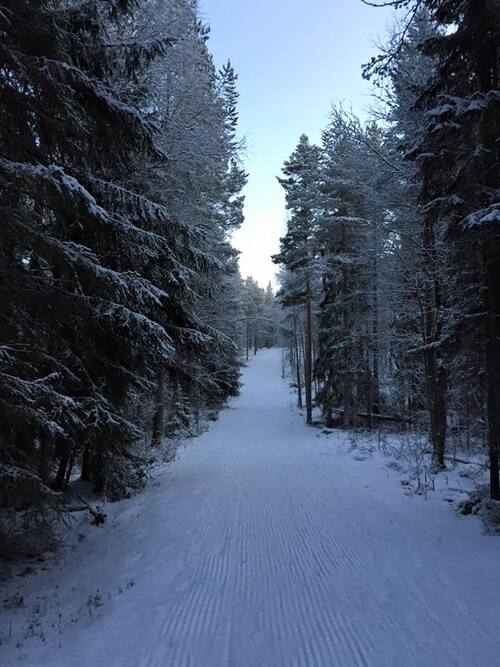-
One of the most extraordinary features of Finland is light. When the endless sunny summer nights give way to winter without sun, northern lights illuminate the sky of their magical show.
The more you head north, the greater your chances of seeing the Northern Lights: sometimes they show up to 200 nights a year in Finnish Lapland. As for Helsinki and southern Finland, the bright lights of holes manifest themselves there around 20 nights per year; they are, however, visible if one keeps away from city lights.
To see the northern lights, you have with sufficient dark conditions and the sky cleared, making the late autumn, winter and early spring (September to March) the period the more favorable for their observation. It is good to remember that the best time is between one to two hours before to two hours after midnight. The light burst can be limited to a period of 20 seconds, but the show may as well go on for hours.
How the Northern Lights do they happen? A Sami legend, the light bursts are due to sparks projected in its path by a celestial fox running full speed on the snowy peaks, hence the modern Finnish word "revontulet" (the fox lights), which serves to designate the phenomenon.
Scientists explain in turn these luminous apparitions in referring to "solar winds that send electricity saturated particles toward Earth, where an energy discharge and bright breakthroughs on impact of particles with the atmosphere".
 votre commentaire
votre commentaire
-
The fact that young people in Finland have access to higher education at a higher age than other European countries indicates according to Minister of Education and Culture that the entrance examination system is not more efficient.
Sanni Granhn-Laasonen, the minister of culture and education is open to the idea of eradicating the entrance examinations in higher education. The Government Institute for Economic Research of Finland suggested that the entrance examinations in higher education should be eradicated and replaced by an admission depending on the system performance of the student at the end of its examination of study.
According to the Government Institute for Economic Research, the abolition of examinations encourage more students in revisions of their examination of study and not in the entrance examination for higher education.
 votre commentaire
votre commentaire
-
Internal political of Finland :
Finland is a parliamentary democracy.
The President of the Republic is elected by direct universal suffrage.
The government (in Finnish is Valtioneuvosto or statsrådet in Swedish) is headed by the Prime Minister who is chosen by parliament. The government is composed of the Prime Minister, different central government ministers and an ex officio member, the Chancellor of Justice.
The Parliament (Eduskunta in Finnish or Riksdag in Swedish) is composed of 200 deputies, and constitutionally has the supreme legislative authority in Finland. He can change the constitution, dismiss the government and counter the presidential vetoes. Its acts can not be legally challenged. Laws may be proposed by the government or one of the Eduskunta members, who are elected by proportional suffrage for a period of 4 years.
The parliament, since universal suffrage was introduced in 1906 (including women), was dominated by agrarian parties (centrist party Maalaisliitto currently Suomen Keskusta), Social Democrats (SDP) and left alliance (Vasemmistoliitto). It may be noted that the political spectrum was more marked by the influence of anti-socialist currents (in the Soviet sense) than in other similar countries have had less contact with the USSR.
Parliament of Finland.
External policy of Finland :
Since its accession in 1995, Finland is intended as student EU model. It adopted all European policies, including the single currency. She applied to the letter the criteria of the Stability Pact and growth after the introduction of the euro, and ensured respect strictly the criteria set by the Pact on fiscal deficit and debt.
Finland is a neutral country since 1955, and is not part of OTAN, but develops an interoperability program forces with OTAN.
Finnish people in general have long been convinced that the country must ensure its own survival, that anyone will never come to his aid. Even wrong, these myths influence the public debate. They add to the desire not to alienate the large neighboring Russia and the fear of having to fight in wars decided by the United States. So, between 60% and 70% of citizens are opposed for 20 years to the country's entry into OTAN.
 votre commentaire
votre commentaire
-
Flag Finland :

The flag of Finland, called siniristilippu (the flag at the Blue Cross), dates from 1918 and is based on the model of the flag of Denmark. It represents the blue Scandinavian cross on a white background.
Blue represents lakes and sky while white symbolizes the snow and the white nights of the Finnish summer.
Salutations :
The most common form of greeting in Finland is to shake hands. Close friends and family members can also greet by taking in her arms. A kiss is not usual.
Discussion and interaction :
The Finns do not talk easily with people they do not know. This is why the Finns may seem quiet and unamiable.
Food and drinks :
Finnish cuisine is typical large part of Europe. It includes meat, fish, potatoes, rice or pasta. It is customary to eat two hot meals during the day: lunch and dinner. In Finland, adults also drink milk with their meals.
We drink a lot of coffee in Finland. For example, at parties, it is almost always coffee. During working meetings, we often drink coffee.
Alcoholic drinks are quite expensive in Finland and their sale is prohibited to minors. It is illegal to drive under the influence of alcohol and this is severely punished.
Sauna :
The sauna is an important part of Finnish culture. The sauna is for get washed and relaxing. Many Finns go to the sauna every week. We go to the sauna as well with family members, friends, the colleagues. Women and men go to the sauna separately. It usually goes naked in the sauna.
Being invited to a Finnish family :
The Finns do not wear shoes in the interior spaces. It is polite to remove your shoes when you enter someone's home. If you visit a Finnish home, remove your shoes or ask if you can keep your shoes.
Large celebrations in Finland :
The Independence Day (Itsenäisyyspäivä) is a national holiday commemorating the country's independence December 6, 1917.
In Finland Vappu is one of the biggest holidays of the year. The celebration begins on 30 April in the evening and is an opportunity for wide consumption of sparkling wine and various alcohols. From the late nineteenth century, this traditional festival of the affluent has become that of students going to university who have received their caps. The traditions include the consumption of a fermented beverage (sima), whose alcohol content can vary. The festivities also include a picnic on May 1, in public parks of major cities.
 votre commentaire
votre commentaire
-
I am in Kajaani for one semester, a student at Kamk, the University of Applied Sciences. This is a city that is in the middle of Finland, in an area where there are many lakes.
It is a university that offers several programs: Business, Sport, Nursery ...
The university has welcome us, from day one, members of the student office spent the day with strangers for us to visit the campus and the city.
I live on campus, sharing with three other students, including a Russian and a German.
I study one semester Business program taught in English. It's amazing, we are a majority of foreigners in classes, we have France, Russia, Germany, Austria, Netherlands, Belgium, England, Spain ... and the other half is Finnish.
The courses are different here, it seems that students are more relaxed in class, with fewer constraints, however, respect between student and teacher is very present. We have little homework, but many group work, much like in France.
Student life is present in Kamk, there is a student association who organizes parties, sports events ...
Here are some photos taken during a walk in Kajaani :
 votre commentaire
votre commentaire Suivre le flux RSS des articles
Suivre le flux RSS des articles Suivre le flux RSS des commentaires
Suivre le flux RSS des commentaires







